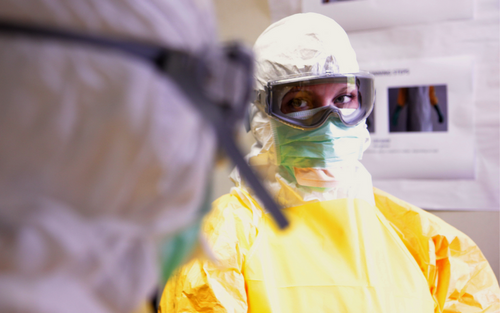How to Safely Remove Contaminated PPE
Field decontamination can be a complicated process, and it’s one that should be taken very seriously. Proper doffing procedures require a well-trained team to avoid contamination hazards from biological, toxic, or otherwise dangerous worksite hazards. Your personal protective equipment (PPE) won’t necessarily be safe for reuse after you remove it, as a lot of hazmat gear is designed for limited use, but it depends on your work and your gear. While specific details will vary depending on what you do, following these general guidelines for removing your protective clothing can keep you safe.
Your Decontamination Area
Leave your contaminated area (hot zone). If you’re using a SCBA respirator unit, make sure you have enough air to get through decontamination and garment removal. Keep using your respirator throughout the whole process. Step into a liquid containment area (which can be as simple as an inflatable kiddie pool as long as it contains rinse and wash liquids) to get scrubbed down. Always get assistance from someone who knows about doffing procedures and is properly equipped (with waterproof gloves, liquid splash protective goggles, protective clothing, and respiratory protection) when rinsing, drying, and disinfecting. Make sure you can properly wash your hands because you’ll be doing it in between each piece you remove (yes, even when your hands are still in gloves—hand hygiene on gloves also helps avoid contamination hazards).
Outerwear
Remove outerwear with safety gloves still on and while touching as little of the outside garment as possible. Aprons, hazmat suits, overshoes, gowns, and outer gloves should be torn off and rolled inside-out and disposed of safely, starting from the head and shoulders and working your way down and while leaning forward. Anything reusable should be placed in a container with proper disinfectant.
Face Protection
If you’re wearing a head cover, remove it from behind the head. Remove face protection and goggles from behind the head, and place them in a separate container for reprocessing. Make sure the area around the face seal of your respirator is disinfected and dried before it can be removed. When removing face masks or respirators, untie the bottom string first and let it dangle in front of you, and then undo the top string. If you’re using SCBA, you can remove the harness and tanks now.
Foot and Hand Protection
Wearing rubber boots or overshoes? Remove them without touching them. If you’re going to wear them outside of the hot zone, keep them on but clean and decontaminate them before leaving the doffing area (boots should be disinfected, rinsed, and dried at least once a day). Remove your final gloves carefully and with the appropriate technique and dispose of them safely. Perform one last hand-washing and leave, secure in your decontamination procedures.
Do you have other decontamination, PPE, or workplace safety questions? Contact a PK Safety expert online or call 800.829.9580.
Recent Posts
-
Customizing Gas Detectors: Tailoring Solutions to Fit Your Unique Requirements
In today’s diverse industrial landscape, a one-size-fits-all approach to safety simply doesn’t cu …Jul 3rd 2024 -
10 Ways to Prevent Wildfires
You can prevent wildfires by extinguishing flames before you leave the worksite. Avoid practicing …Jul 1st 2024 -
ANSI/ISEA 138 Safety Gloves: Ensuring Hand Protection
The human hand is an anatomical masterpiece and arguably the greatest tool attached to our bodies …Jun 25th 2024





